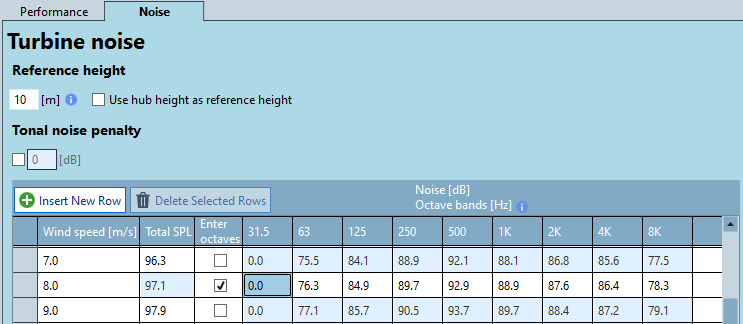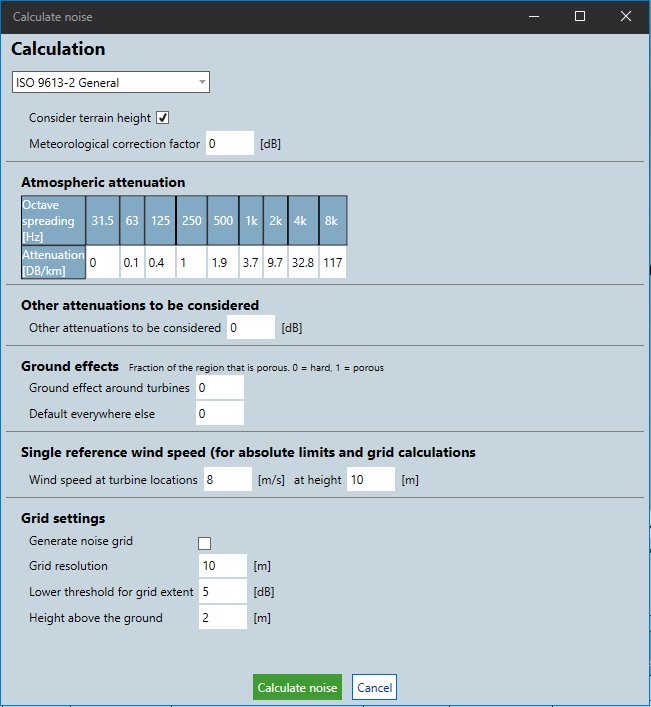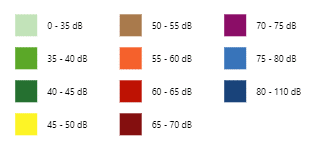Noise Impact
The modelling of the noise caused by wind turbines is based on the definition of source, receiver and transmission. All noise calculations consider the 3-dimensional distance between source and receiver and thus require terrain data in form of a Digital Terrain Model (DTM) file containing gridded elevations to be loaded first. If no DTM file is loaded, WindFarmer will give you the option of using a flat-earth calculation. The flat-earth calculation can also be selected by deselecting "Consider terrain height" in the Noise Calculation settings dialog.
Further information on the noise propagation models and parameters is provided in the WindFarmer Calculation Reference.
Noise Emission at Turbines
Noise data, as supplied by the turbine manufacturer, are defined in the Noise tab of each Turbine Mode definition in the Turbine Types task. Inputs include the total sound power level of the turbine, tonal penalties and, when available, the octave-specific sound power levels for the turbine.

Sound power levels are defined for a specific windspeed at a reference height. Any number of windspeeds may be specified to allow the user to model the turbine noise level at a range of wind speeds. Currently, octave band data may only be entered for one of the specified windspeeds. Octave bands for other windspeeds are calculated assuming that the same variation over windspeed occurs for each frequency band as for the total power level.
Noise Immission at Receptors
Noise Sensitive Receptors are used to define buildings or other locations where the noise from the wind farm is not permitted to exceed a particular value. The location of a building can be identified using a background reference image, or by entering the coordinates in the Receptors table in the Receptor location task of the Environment chapter.
The noise limits set at the receptor locations must be adhered to in order for a turbine layout to be legal.
Noise Receptor Settings
The maximum allowable noise level at the receptor, in dB, is defined in the Noise Receptor Settings task. There are three options for noise limits:
- Absolute (using single windspeed)
- Relative to Background Noise
- Higher of “Relative to Background” or “Absolute”

The Absolute option does not consider background noise information. It calculates noise levels according to the propagation from the turbine noise sources only, assuming a constant windspeed at all turbines (set in the Noise Calculation settings dialog).
The acoustic porosity can be defined for the surroundings of a receptor as a Ground Effect parameter. Explanations and typical values for this parameter are given in the WindFarmer Calculation Reference.
The Noise Receptor Properties include the height of the noise receptor above the ground. The default is 2m.
Background Noise Measurements
For the options including Background Noise, it is assumed that background noise data are measured as a function of wind speed at one or more Background Noise Reference points.
These will be at locations that are representative for a number of buildings/receptors. Multiple Receptors can use the same background noise measurement. In Noise Receptors Properties, there is a tab where Background Noise Reference measurements can be entered.

In the Background Noise Reference table enter the measured background noise values as a function of wind speed. Also enter the mean wind speed at the reference point. This is compared by the model with the mean wind speed at each turbine location and used as a scaling factor. Use Add New and Delete buttons to add and edit the data for several reference points. Copy and Paste buttons allow contents of a group of cells to be copied between reference points. The data are stored in the workbook and are available for assigning to any of the Noise Receptors.
Use the column “Relative to Background Noise” to enter the acceptable difference between the Background Noise and the noise from the turbines, and choose whether the combination of Absolute and Background Noise is required.
Noise Propagation and Calculation Settings
The Noise Settings dialog of the Noise Calculation task allows the user to select which noise model is to be used for all noise calculations (Simple, Complex (ISO9613) General, Complex (ISO9613) Alternative or Custom).

The parameters of the noise models are defined here and the calculation is also run from this dialog. Please see ISO9613 and the WindFarmer Calculation Reference for details on the noise model.

The Simple model is the fastest. Please use it when running an automatic layout optimisation. It allows a conservative approximation of the expected noise level using the Total sound power level, propagated at a representative frequency of 500 Hz.
The Complex General and Complex Alternative models follow the recommendations of ISO9613 and always includes the analysis of octave bands and ground absorption.
Please note if calculating the noise propagation in octave bands without defining the octave band noise emissions for a turbine type, the total sound power level will be used as the 500Hz octave band with all other octave bands set to 0dB. In this case the Complex General model and the Simple model will give similar results.
Noise Results at Receptors
Once noise at receptor locations has been calculated, the results are displayed in a table at the bottom of the Calculation task view. In the case of noise limits relative to background noise, the value shown is for the windspeed showing the worst case noise relative to background noise.

The full results relative to background noise are displayed in the Over wind speed tab. Selected rows may be displayed in the accompanying chart

The results relative to limits are also displayed on the map view by colour coding of the receptor icon as follows:
| not calculated | below limit | within 90% of the limit | above the limit |
Noise Mapping
To calculate a noise map check the "Calculate grid" box in the Noise Calculation settings dialog. The resolution of the grid may also be set.
After a change in layout or turbine properties, the noise map may be recalculated from the Calculation task without reopening the settings dialog box.
Noise Map data may be exported in contour or grid formats.
